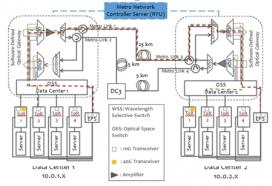Software That Automatically Adapts Connection Capacity Will Encourage Smaller Data Centers
Scientists demonstrated that software can dynamically adapt fiber-optic connections between data centers to meet the fast-changing Internet demands at different locations. The software-defined optical switching was developed through the Center for Integrated Access Networks (CIAN), an NSF-funded Engineering Research Center (ERC) based at the University of Arizona.
The software adds new flexibility to data centers to automatically overcome congestion, a capability not in available in networks today. The innovation will encourage the use of smaller data centers in crowded metropolitan areas where Internet demands can vary widely, such as the surges in wireless Internet usage when large crowds assemble for concerts, fairs, or other events.
Smaller data centers not only require less space, but can be positioned closer to end-user needs, including details on local buildings and services. Each data center, however, in today’s environment would need a fixed number of optical connections that, if designed to meet surges in data demand, would prove excessive at other times.
The software-defined networking control plane developed by a team at Columbia University, a CIAN partner institution, allows the fiber-optic connections to automatically adjust to demand. The technology adapted to demand through three methods: telemetry-based adjustments of aggregate capacity as traffic varied, on-demand optical circuit switching, and capacity adaptation between 10 Gb/s and 40 Gb/s connections.



